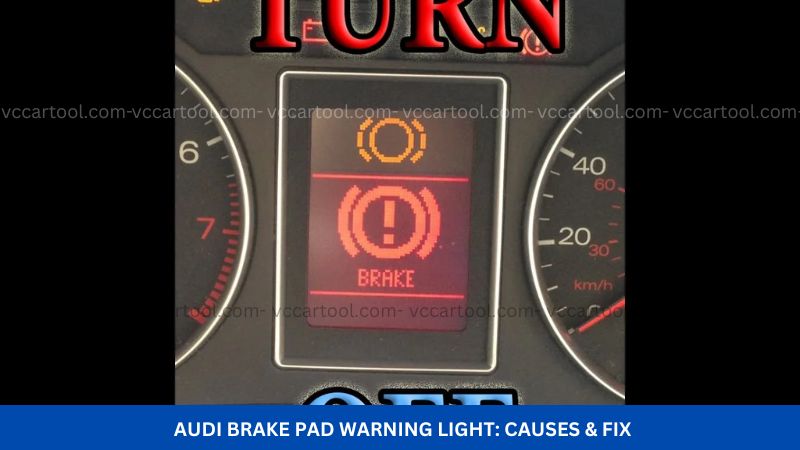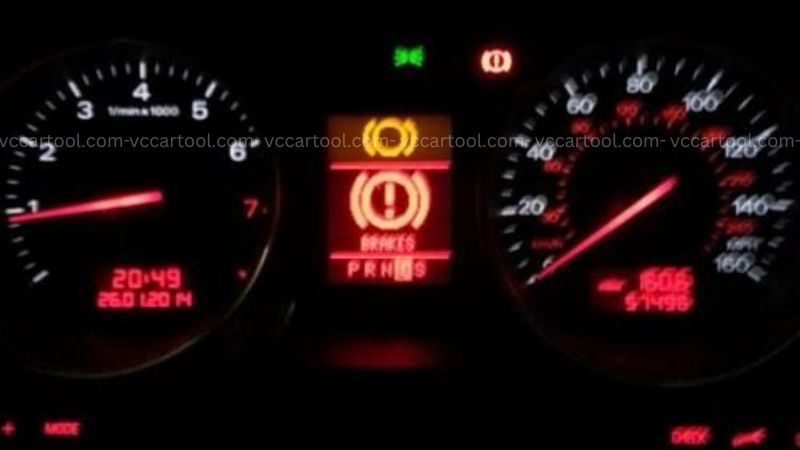Audi Brake Pad Warning Light: Causes & Fix
The illumination of your Audi brake pad warning light at just 23,000 miles might raise concerns about your vehicle’s safety and the lifespan of your brake components. It’s natural to wonder if this indicates a larger issue with your braking system. This detailed guide will explore the reasons behind this early warning, the necessary immediate actions, and how utilizing the appropriate Audi diagnostic tools, particularly those offered by VCCarTool, can help maintain your braking system for sustained safety and optimal performance.

1. Understanding the Audi Brake Pad Warning Signal
The Audi brake pad warning light is a crucial element of your car’s sophisticated brake wear indicator system. This system employs specialized sensors to continuously monitor the condition and thickness of your brake pads. Once these pads wear down to a pre-determined critical level, the sensor activates the warning light on your dashboard. This serves as a clear indication that your brake pads require inspection and likely replacement to guarantee continued safe and effective braking. Recognizing this signal promptly is paramount for your safety and the longevity of your braking system.
This intelligent warning system typically incorporates small electronic sensors integrated directly into the brake pad assembly. As the friction material of the brake pads gradually wears away through normal use during braking, these sensors eventually make contact with the surface of the brake disc rotor. This physical contact completes an electrical circuit, which in turn triggers the illumination of the warning light in your Audi’s instrument cluster. While specific implementation details might vary slightly across different Audi models, the fundamental principle of detecting excessive brake pad wear remains consistent. Ignoring this visual alert can lead to further damage to other vital components of the braking system, such as the rotors themselves, potentially resulting in more complex and costly repairs down the line. Addressing a low brake pad alert without delay is a cornerstone of responsible vehicle ownership and maintenance.

2. Why the Audi Brake Pad Light at 23,000 Miles? Common Causes
Experiencing the Audi brake pad warning light at a relatively low mileage of 23,000 miles can be due to several factors:
-
Aggressive Driving Habits: Frequent hard braking, rapid acceleration followed by sharp deceleration, and overall spirited driving can significantly accelerate the wear of your brake pads.
-
Stop-and-Go Traffic: Driving predominantly in urban environments characterized by constant stop-and-go traffic puts a greater demand on your brakes compared to highway driving, leading to faster wear.
-
Brake Pad Material Composition: Different types of brake pads have varying levels of durability. Softer, more performance-oriented pads might offer superior stopping power but tend to wear out more quickly than harder, more durable compounds.
-
Underlying Mechanical Issues: In some instances, premature brake pad wear can be a symptom of other problems within the braking system. Misaligned or sticking brake calipers can cause uneven pressure on the pads, leading to accelerated wear on one side or wheel. Issues with the brake rotors, such as warping or uneven surfaces, can also contribute to faster pad wear.
-
Manufacturing Variations: While less common, there can be slight variations in the manufacturing process of brake pads that might result in some pads wearing out sooner than others.
| Cause | Description | Potential Impact at 23k Miles |
| Aggressive Driving | Frequent hard braking and rapid deceleration. | Increased wear |
| Stop-and-Go Traffic | Constant braking in urban environments. | Accelerated wear |
| Pad Material (Softer) | Performance-oriented pads may have a shorter lifespan. | Faster depletion |
| Caliper Issues | Sticking or misaligned calipers causing uneven pressure. | Uneven and rapid wear |
| Rotor Issues | Warped or uneven rotors contributing to faster pad wear. | Accelerated wear |
| Manufacturing Variations | Slight differences in pad production can affect lifespan. | Potentially quicker wear |
3. Immediate Actions: Responding to the Warning Light
When the Audi brake pad warning light illuminates, taking the following steps is crucial for your safety and the well-being of your vehicle:
-
Maintain Composure and Drive Defensively: It’s important to remain calm. Adjust your driving style immediately by avoiding sudden, hard braking. Increase your following distance from other vehicles to allow for more gradual deceleration.
-
Conduct a Preliminary Inspection (If Safe): If you feel comfortable and it’s safe to do so, visually inspect your brake pads through the spokes of your wheels. Look for the thickness of the remaining friction material. Also, listen for any unusual noises when braking, such as squealing, grinding, or scraping, which could indicate severely worn pads.
-
Schedule a Professional Brake System Inspection Promptly: The appearance of the warning light warrants a thorough inspection by a qualified mechanic or your Audi service center. Do not delay this. Request a comprehensive examination of your entire braking system, including the brake pads, rotors, calipers, and brake fluid level and condition.
-
Limit Driving If Possible: Until your brakes have been professionally inspected, it is advisable to limit your driving as much as possible. If driving is unavoidable, exercise extreme caution, avoid high speeds and heavy traffic conditions.
4. What to Expect During Your Audi Brake Inspection
A comprehensive Audi brake inspection will typically involve the following steps:
-
Brake Pad Thickness Measurement: The mechanic will use a specialized gauge to precisely measure the thickness of your brake pads. New brake pads generally have a friction material thickness of around 8 to 12 millimeters. Replacement is typically recommended when the thickness reaches 3 millimeters or less.
-
Brake Rotor Inspection: The rotors will be visually inspected and measured for signs of wear, such as grooves, scoring, warping (lateral runout), and thickness. There are minimum thickness specifications for brake rotors, and if they fall below this limit or exhibit significant damage, they will need to be resurfaced (if within tolerance) or replaced.
-
Brake Fluid Evaluation: The mechanic will check the brake fluid level and its condition. Brake fluid absorbs moisture over time, which can lead to corrosion within the braking system and a reduction in braking performance. The fluid might be tested for moisture content and contamination.
-
Brake Caliper Functionality Check: The calipers will be inspected for leaks, corrosion, and proper function. The mechanic will ensure that the caliper pistons are moving freely and applying even pressure to the brake pads. Sticking or seized calipers can cause uneven pad wear and other braking problems.
| Component | Ideal Condition | When Replacement/Service is Typically Recommended |
| Brake Pads | 8-12 mm thickness | Below 3 mm |
| Rotors | Smooth surface, within thickness spec | Warped, cracked, significant grooves, below min. thickness |
| Brake Fluid | Clear, correct level, low moisture | Contaminated, low level, high moisture content |
| Calipers | Smooth operation, no leaks | Sticking, leaking, or seized |
5. Audi Brake Pad Lifespan and Replacement Considerations
While the general lifespan of brake pads can range from 30,000 to 70,000 miles, the fact that your Audi’s warning light activated at 23,000 miles highlights that several factors can lead to earlier replacement. It’s important to address the warning promptly regardless of mileage.
Factors significantly influencing brake pad longevity include:
-
Your Driving Style: As mentioned earlier, aggressive braking habits drastically reduce brake pad life.
-
Driving Environment: Frequent city driving with its constant stopping and starting will wear down brake pads faster than predominantly highway driving.
-
The Type of Brake Pads: The material composition of your brake pads plays a crucial role. Ceramic brake pads are generally known for their longevity and low dust production, while organic or semi-metallic pads might offer different performance characteristics but potentially shorter lifespans.
-
Vehicle Load: Regularly carrying heavy loads puts additional strain on your braking system, leading to increased wear.
6. Proactive Measures: Preventing Premature Brake Pad Wear
Adopting certain driving habits and maintenance practices can help extend the life of your Audi’s brake pads:
-
Practice Gentle Braking: Anticipate stops and decelerate smoothly whenever possible, avoiding abrupt, hard braking.
-
Maintain Safe Following Distances: This reduces the need for sudden braking.
-
Avoid Excessive Speeding: Higher speeds require more forceful braking to stop.
-
Minimize Carrying Unnecessary Weight: Reducing the load on your vehicle lessens the stress on the braking system.
-
Schedule Regular Brake Inspections: Incorporate brake inspections into your routine vehicle maintenance schedule. Early detection of minor issues can prevent premature wear.
7. Understanding Audi Brake Pad Replacement Costs
The cost of Audi brake pad replacement can vary depending on factors such as the specific model of your Audi, the type of brake pads used (OEM vs. aftermarket), and the labor rates of the repair shop. Here are some general estimated costs in USD:
| Service Type | Estimated Cost (USD) | Notes |
| Front Brake Pad Replacement | $150 – $400+ | Includes pads and labor. Higher for performance pads or dealer service. |
| Rear Brake Pad Replacement | $130 – $350+ | Includes pads and labor. |
| Brake Rotor Resurfacing (per axle) | $100 – $200+ | Only possible if rotors are within minimum thickness specifications. May not always be recommended. |
| Brake Rotor Replacement (per axle) | $250 – $600+ | Includes new rotors and labor. Often recommended with pad replacement for optimal performance. |
| Brake System Inspection | $50 – $150 | Cost of a thorough professional brake system check. |
Note: These are just estimates, and actual costs may vary. It’s always best to get a quote from your preferred mechanic or Audi service center.
8. The Role of VCCarTool in Audi Brake Service
For automotive technicians and garage owners, having access to advanced diagnostic tools is essential for efficiently and accurately servicing Audi vehicles, including their braking systems. VCCarTool offers a range of diagnostic solutions that can significantly enhance your ability to address Audi brake pad warning lights and related issues.
-
Precise Diagnostics: VCCarTool diagnostic scanners provide in-depth access to Audi’s electronic control units, allowing you to read and clear fault codes related to the brake system, including those associated with brake pad wear sensors. This helps pinpoint the exact cause of the warning light.
-
Real-Time Data Analysis: Many VCCarTool devices offer live data streaming, enabling you to monitor the real-time status of brake pad wear sensors, brake pressure, and other crucial parameters. This can be invaluable for diagnosing intermittent problems or confirming sensor functionality.
-
Efficient Reset Procedures: After replacing brake pads and sensors, some VCCarTool tools can facilitate the proper reset of the brake pad wear indicator system, ensuring the warning light is extinguished correctly.
-
Comprehensive System Checks: Beyond just the brake pad sensors, VCCarTool tools often allow for comprehensive checks of other braking system components, such as ABS (Anti-lock Braking System) and ESP (Electronic Stability Program), ensuring all systems are functioning correctly.
-
Enhanced Customer Service: By utilizing VCCarTool’s advanced diagnostic capabilities, you can provide your customers with more accurate diagnoses, faster service, and greater confidence in the repairs performed.
By incorporating VCCarTool into your workshop, you can streamline your Audi brake service procedures, reduce diagnostic times, and ensure that brake pad warning light issues are resolved effectively, contributing to both customer satisfaction and your business’s success.
Encountering the Audi brake pad warning light at 23,000 miles serves as an important reminder to have your braking system inspected without delay. Whether the early wear is attributed to driving habits, environmental factors, or other mechanical influences, addressing this warning promptly is paramount for your safety and the longevity of your vehicle. By scheduling a professional brake inspection, adhering to recommended maintenance practices, and prioritizing safe driving habits, you can help ensure the continued reliability and performance of your Audi’s braking system.
For automotive professionals, utilizing advanced diagnostic tools from VCCarTool can significantly enhance your ability to diagnose and resolve these issues efficiently and accurately.
